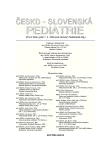Shaken Baby Syndrome
Authors:
D. Průchová; M. Velemínský
Authors‘ workplace:
Jihočeská univerzita v Českých Budějovicích, Zdravotně sociální fakulta, České Budějovice
děkan fakulty prof. MUDr. M. Velemínský, CSc., dr. h. c.
Published in:
Čes-slov Pediat 2010; 65 (4): 179-183.
Category:
Review Article
Overview
The Shaken Baby Syndrome (SBS) refers to a group of symptoms encountered in children traumatized by (violent) shaking. They concern especially microtrauma in the brain tissue. The diagnosis is difficult, and the parents are often unaware of the fact of using shaking of the babies as a method of soothing in unceasing crying.
In contrast to the United Stated, the Czech Republic, together with the western European countries, does not have a sufficient number of data on the occurrence of SBS. It is therefore important to increase the awareness of this syndrome, to extend education and direct it also to the layman public.
Key words:
Shaken Baby Syndrome, unceasing child cry, preventive activities
Sources
1. Caffey J. On the theory and practice of shaking infants: its potential residual effects of permanent brain damage and mental retardation. Am. J. Dis. Child. 1972; 124: 161–169.
2. Palmer S. Syndrom třeseného dítěte. [online] [cit. 2009-11-10] Dostupné z: http://www.dobromysl.cz/scripts/detail.php?id= 620&tmplid=45
3. Deyo G, Skybo T, Carroll A. Secondary analysis of the “Love Me... Never Shake Me” SBS education program. Child Abuse Negl. 2008; 32(11): 1017–1025.
4. Fedor M, Ďurdík P, Buchanec J. Syndrom trasenia dieťatom. Pediatrie pro praxi. [online] 2005 [cit. 2009-11-10]. Dostupné z: http://www.solen.sk/index.php?page=pdf_view&pdf_id=768
5. Stanková S. Nikdy dítětem netřeste! [online] 2. 4. 2007 [cit. 2009-10-21] Dostupné z: http://www.rodina.cz/clanek5609.htm
6. Doležel Z. Dítětem nikdy netřeste! [online] 2007 [cit. 2009-10-21] Dostupné z: http://mladazena.maminka.cz/scripts/detail.php?id =320452
7. Lazoritz S, Palusci JV. The Shaken Baby Syndrome: A Multidisciplinary Approach. 1st ed. London: Harwort Press, 2002: 1–411.
8. Minns R, Brown K. Shaking and Other Non-accidental Head Injuries in Children. 1st ed. London: Mac Keith, 2005: 1–512.
9. Matschke J, Herrmann B, Sperhake J, et al. Shaken baby syndrome: a common variant of non-accidental head injury in infants. Dtsch. Arztebl. Int. 2009; 106 (13): 211–217.
10. Felekis T, Asproudis I, Gorezis S, et al. Shaken baby syndrome: intending to harm or attempting to help? Eur. J. Ophthalmol. 2008; 18(5): 819–821.
11. Peychl I. Shaken baby syndrome. Čas. Lék. čes. 2005; 144: 185–187.
12. Laurent-Vannier A, Toure H, Vieux E, et al. Long-term outcome of the shaken baby syndrome and medicolegal consequences: a case report. Ann. Phys. Rehabil. Med. 2009; 52(5): 436–447.
13. Reith W, Rother T, Ahlhelm F, et al. Shaken baby syndrome. Der Radiologe 2009; 49: 926–931.
14. Barr RG, Rivara FP, Barr M, et al. Effectiveness of educational materials designed to change knowledge and behaviors regarding crying and shaken-baby syndrome in mothers of newborns: a randomized, controlled trial. Pediatrics 2009; 123(3): 972–980.
15. Barr RG, Barr M, Fujiwara T, et al. Do educational materials change knowledge and behaviour about crying and shaken baby syndrome? A randomized controlled trial. CMAJ 2009; 180(7): 727–733.
16. Goulet C, Frappier JY, Fortin S, et al. Development and evaluation of a shaken baby syndrome prevention program. J. Obstet. Gynecol. Neonatal. Nurs. 2009; 38(1): 7–21.
17. Christian CW, Block R. Abusive head trauma in infants and children. Pediatrics 2009; 123(5): 1409–1411.
18. Gill JR, Goldfeder LB, Armbrustmacher V, et al. Fatal head injury in children younger than 2 years in New York City and an overview of the shaken baby syndrome. Arch. Pathol. Lab. Med. 2009; 133(4): 619–627.
19. Lee C, Barr RG, Catherine N, et al. Age-related incidence of publicly reported shaken baby syndrome cases: is crying a trigger for shaking? J. Dev. Behav. Pediatr. 2007; 28(4): 288–293.
20. Wirtz SJ, Trent RB. Passive surveillance of shaken baby syndrome using hospital inpatient data. Am. J. Prev. Med. 2008; 34(4): 134–139.
21. Kobayashi Y, Yamada K, Ohba S, et al. Ocular manifestation and prognosis of shaken baby syndrome in two Japanese children´s hospitals. Jpn. J. Ophtalmol. 2009; 53(4): 384–388.
22. Talvik I, Alexander RC, Talvik T. Shaken baby syndrome and a baby’s cry. Acta Paediatr. 2008; 97(6): 782–785.
23. Kelly P, Farrant B. Shaken baby syndrome in New Zealand, 2000–2002. J. Paediatr. Child. Health 2008; 44(3): 99–107.
24. Mraz MA. The physical manifestations of shaken baby syndrome. J. Forensic. Nurs. 2009; 5(1): 26–30.
Labels
Neonatology Paediatrics General practitioner for children and adolescentsArticle was published in
Czech-Slovak Pediatrics

2010 Issue 4
- What Effect Can Be Expected from Limosilactobacillus reuteri in Mucositis and Peri-Implantitis?
- The Importance of Limosilactobacillus reuteri in Administration to Diabetics with Gingivitis
Most read in this issue
- Progressive Familial Intrahepatic Cholestasis
- Shaken Baby Syndrome
- Modelling the Development of Body Height (Length) in Children Using Parental Height Data
- Epidemiology of Non-fatal Accidents and the Development of the Accident Rate in Children over the Past Decade in the Czech Republic. A Shift in the Hitherto Trend?
